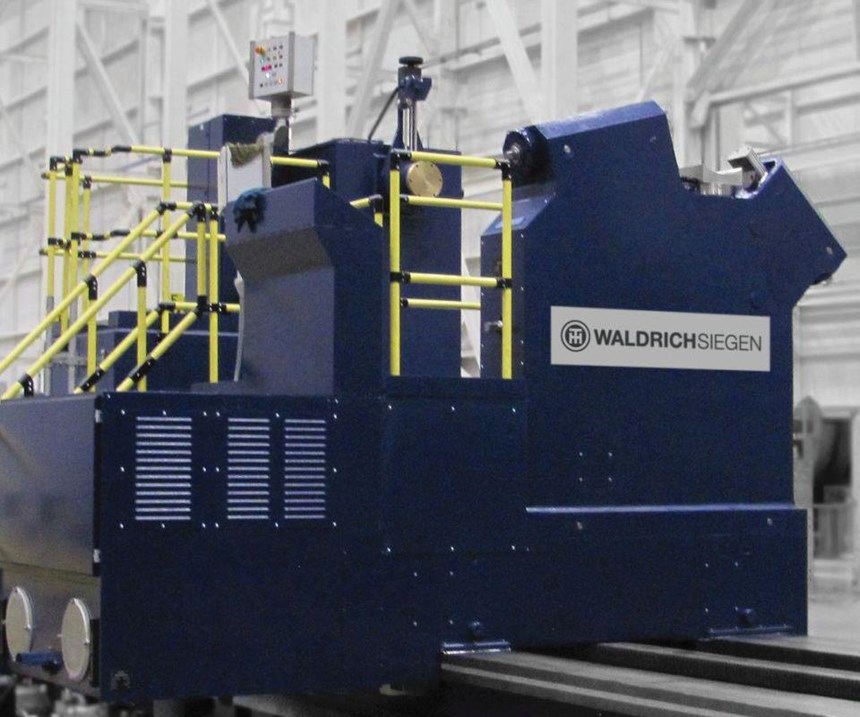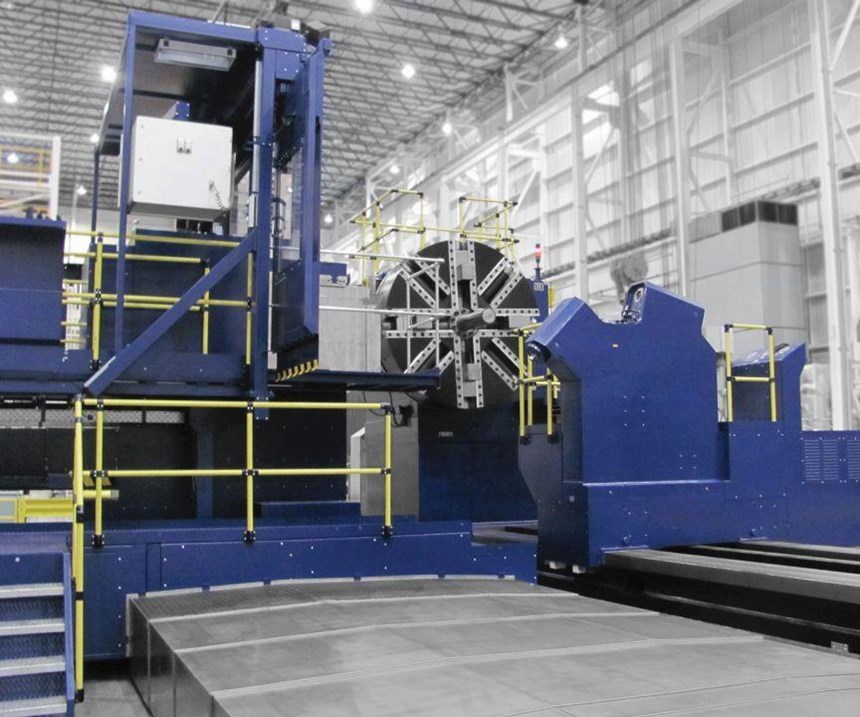Turning Precision into Power
Mitsubishi Hitachi Power Systems Americas Inc. needed the power to turn large workpieces to very tight tolerances. ProfiTurn H lathes from WaldrichSiegen brought high accuracy and minimal downtime.
Share



Takumi USA
Featured Content
View More

Hwacheon Machinery America, Inc.
Featured Content
View More

.png;maxWidth=45)
DMG MORI - Cincinnati
Featured Content
View More
Autodesk, Inc.
Featured Content
View More
Providing millions of households with electric power is a great responsibility—one that Mitsubishi Hitachi Power Systems Americas Inc. (MHPSA) does not take lightly. That’s why it insists that each component of its J-series gas turbine has to be manufactured to high quality standards. Since 2012, MHPSA has operated ProfiTurn H lathes from WaldrichSiegen to machine its gas and steam turbine rotors, and using these customized lathes has enabled the company to minimize downtime while machining to very tight tolerances.
MHPSA is a manufacturer of power-generation systems for large utility companies such as Southern Co., Georgia Power, and Florida Power and Light. A subsidiary of Mitsubishi Heavy Industries Ltd. that later merged with Hitachi Ltd., the company produces steam and gas turbines in Savannah, Georgia. Its J-series gas turbine, which is capable of operating at temperatures ranging to 1,600°C (2,912°F), can produce more than 327 MW of power in a single cycle and 470 MW in a combined cycle.
The challenge of finding a lathe for this application was twofold: It had to have the power plus the precision necessary to accurately machine turbine rotors that can weigh as much as 200 tons and that rotate at 3,600 rpm during operation, says Russell Gamblin, maintenance and facilities manager. The company turned to WaldrichSiegen, a lathe manufacturer with 175 years of experience in various industries, for a solution. Based in Germany, WaldrichSiegen designs and manufactures customized, heavy-duty machine tools for complex turning operations.
“In 2010, we received an order from MHPSA comprising two customized lathes to machine gas and turbine rotors. Our ProfiTurn H series seemed like the ideal solution for the task, and it was. The order for another lathe followed a year later,” says Marco Tannert, president of WaldrichSiegen.
The ProfiTurn H series is designed to machine large, heavy, rotationally symmetrical workpieces. Delivered in 2012, the largest of the three lathes built for MHPSA machines workpieces with diameters ranging to 205 inches (5,200 mm), lengths to 571 inches (14,400 mm) and weights to 200 tons. It has a drive power of 310 kW and a torque of 200,000 Nm. In close cooperation with MHPSA, WaldrichSiegen tailored the lathe specifically to machine rotors at very tight tolerances and very high metal removal rates.
The lathe is designed to combine great machining force with high precision. For instance, MHPSA requested axial runout of less than 7 microns and radial runout of less than 15 microns, Mr. Tannert says. In order to reliably meet those tolerances, the lathe operates with an axial and radial runout tolerance of 5 microns. “Combining these accuracies with a maximum cutting force of 12 tons and 10 tons at the two tools provides an unparalleled machining performance,” Mr. Tannert says.
To meet such high operating standards, the entire ProfiTurn H machine structure is designed to be extremely rigid. Its X and Z axes are hydrostatically guided for precise, wear-free operation and excellent thermal characteristics. “The rigid hydrostatic design and the robust structure are definitely highlights of the machine,” Mr. Gamblin says. The carriage is driven along the Z axis by a preloaded double-pinion drive. The hydrostatic guideway system provides extremely high dynamic stiffness, which is crucial for the complex machining tasks required by MHPSA.
Turbine rotors pose a number of complex machining challenges. For instance, journal machining for steam and gas turbine rotors is one of the most critical tasks, Mr. Gamblin says. The required tolerance is +50/-0 microns. During operation, the rotor rotates at 3,600 rpm. The surface must match the bearing surface on the pedestal exactly, he says.
In addition to the rigid, hydrostatic machine design, a key factor to achieving the extremely high runout accuracy and performance necessary is precise positioning of the workpiece. The ProfiTurn H lathe is equipped with a counterstay instead of a tailstock for turning the rotors in steady rests. The counterstay monitors the positioning of the rotor and is designed to prevent axial displacement. The hydrostatic steady rests add to the stiffness required for concentricity in micron range and the damping characteristics of the entire machine. According to Mr. Gamblin, the steady rests in particular increase overall shopfloor efficiency.
“In comparison to other large lathes in operation at our facility, the ProfiTurn H lathes are set up more easily due to a better hydrostatic steady rest design,” he says. The rotors are precisely positioned in the lathe with the help of a hydraulically adjustable quill. Clamping spindles with quick-adjustment function enable fast and easy clamping and adjustment of the workpieces. The optimized guidance of the clamping jaws and deflection protection of the clamping spindles further increase the workpiece clamping accuracy. These features are designed to keep the machines running smoothly and reliably in their day-to-day operations.
The two smaller lathes can accommodate workpieces that weigh as much as 100 tons, with diameters ranging to 87 inches (2,200 mm), and lengths ranging to 413 inches (10,500 mm) and 354 inches (9,000 mm), respectively. They are said to machine gas and steam turbine rotors as accurately as the larger lathe, but they also perform repair and revamp tasks in MHPSA’s service business.
Operating ProfiTurn H lathes has strengthened the efficiency of the entire production, Mr. Gamblin says. “They have the least amount of downtime. Due to that and the excellent support from KPM, the WaldrichSiegen service unit in Ford City, Pennsylvania, we have significantly improved our processes and efficiency.”
Related Content
4 Tips for Staying Profitable in the Face of Change
After more than 40 years in business, this shop has learned how to adapt to stay profitable.
Read MoreIndustry Analysis: Machining Semiconductor Components
With many machine shops anticipating long-term growth in demand from the semiconductor industry, it is worth the time to heed the advice of manufacturers who have already been servicing this end-market for years.
Read MoreCNC Machine Shop Honored for Automation, Machine Monitoring
From cobots to machine monitoring, this Top Shop honoree shows that machining technology is about more than the machine tool.
Read MoreQuick-Change Tool Heads Reduce Setup on Swiss-Type Turning Centers
This new quick-change tooling system enables shops to get more production from their Swiss turning centers through reduced tool setup time and matches the performance of a solid tool.
Read MoreRead Next
Registration Now Open for the Precision Machining Technology Show (PMTS) 2025
The precision machining industry’s premier event returns to Cleveland, OH, April 1-3.
Read MoreBuilding Out a Foundation for Student Machinists
Autodesk and Haas have teamed up to produce an introductory course for students that covers the basics of CAD, CAM and CNC while providing them with a portfolio part.
Read More5 Rules of Thumb for Buying CNC Machine Tools
Use these tips to carefully plan your machine tool purchases and to avoid regretting your decision later.
Read More






































.jpg;maxWidth=300;quality=90)











